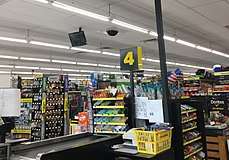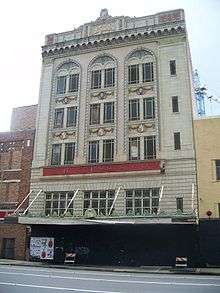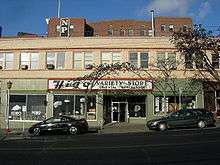Variety store
A variety store (also pound shop, dollar store, five and dime (historic) and other names) is a retail store that sells general merchandise, such as apparel, automotive parts, dry goods, hardware, home furnishings, and a selection of groceries. It usually sells them at discounted prices, sometimes at one or several fixed price points, such as one dollar, or historically, five and ten cents. Variety stores do not include larger formats: general merchandise superstores (hypermarkets) such as Target and Walmart. Warehouse clubs like Costco, grocery stores, and department stores are also not considered variety stores.[1]





History
North America
The common term in North America for a small general merchandise store is general store.
Five and dime stores
Frank Winfield Woolworth had seen the success in Michigan and western New York of so-called nickel stores, where everything cost five cents (the U.S. five cent coin is called a "nickel"). On 22 February 1879, Woolworth opened his Great Five Cent Store in Utica, New York, and it was his later success and expansion of that format as the F. W. Woolworth Company of that would create the American institution of the five and ten cent store, five and dime, or dime store (a dime is the name a U.S. ten-cent coin).[2] Before Woolworth, the prevailing thought was an entire store could not maintain itself with all low-priced goods, but with Woolworth's success, many others followed their lead.[3]
Well-known dime store companies included:[4]
Of these, only Ben Franklin continues to exist in this form, while Kresge and Walton's became mega-retailers Kmart and Walmart, respectively.
Beginning around the 1960s, others tried the larger "discount store" format as well, such as TG&Y Family Centers, W.T. Grant, and Woolworth's Woolco stores.
With suburbanization in the 1950s and 1960s, Americans shopped more and more in malls rather than downtown shopping districts, and Newberry's and Woolworth's stores did open in the malls but even so, starting around the 1970s, variety stores lost business to other retail formats such as office stores, low-price shoe chains, fabric stores, toy stores and discount drug stores like Thrifty Drug Stores. Grocery stores and drug stores sold more and more candy.[5] The last US Woolworth's closed in 1997. Newberry's went bankrupt in 1992 and the brand disappeared in 2002.[6][7] 300 McCrory stores, many of which being Newberry's, closed in 1997,[8][9]
Dollar stores
Starting in the late 1990s, dollar stores had started expanding enough to gain the attention of the national press. They were popular not only due to their value, but because they freestanding smaller stores were located in small towns, downtowns, and across the cities and suburbs, they were often convenient compared to going to the mall.[10] They continued to grow and by 2019, for example, Dollar Tree had higher annual sales than Macy's.[11] Dollar and variety store revenue reached $77 billion in 2018.[12]
As of 2018, main dollar store chains in the U.S. are Dollar General, Dollar Tree (which bought Family Dollar), and Five Below. Dollar stores are booming, with around 14,000 Dollar Tree locations in the U.S. in 2018 and plans to open hundreds more; 15,000 Dollar General locations with plans for 975 more in 2019; and Five Below with 745 stores.[13]
United Kingdom
Woolworth's opened its first store in the United Kingdom in 1909, when they were also colloquially known as "threepenny and sixpenny" stores, "3d and 6d" being displayed on the shops' frontages.[14][15]
Global chains
Miniso is a Chinese variety store chain that specializes in household and consumer goods including cosmetics, stationery, toys, and kitchenware.[16] In 2016, the company's sales revenue reached $1.5 billion.[17] Miniso has expanded outside of the Chinese market and operates 1,800 stores in Asia, Europe, Oceania, Africa, North America, and South America.[18]
Economics
Pricing and margins
Some items are offered at a considerable discount over other retailers, whereas others are at much the same price point. There are two ways variety stores make a profit:
- Buying and selling huge amounts of goods at heavily discounted prices provides a small profit margin that is multiplied by the volume of sales.
- Pricing many items at prices that are higher than regular retailers. These goods are commonly bought by consumers who perceive them to be bargains based on the heavy discounts on other items in the store. In the case of fixed price-point retailers, this can be achieved by reducing the size of the package to one that is smaller than what is found in other retail outlets.[19][20]
Variety stores with single price points buy products to fit those price points (while making a profit) that are:
- generic brands or private labels, often specially manufactured using cheaper materials and processes than usual.[19][20]
- available through the grey market.
- bought at a closeout sale, such as seasonal or promotional goods or bankruptcy stock.
- sold in smaller unit sizes than elsewhere.[19][20]
Not all variety stores are "single price-point" stores, even if their names imply it. For example, in the United States, Dollar General and Family Dollar sell items at more or less than a dollar. Some stores also sell goods priced at multiples of the named price and, conversely, multiple items for the price. The discrepancy with the nominal price is also compounded if sales tax is added at the point of sale.
Supply
In many countries, stock can be imported from others with lower variable costs, because of differences in wages, resource costs or taxation. Usually goods are imported by a general importer, then sold to the stores wholesale.
Another source of stock is overruns, surplus items and out-of-date food products. Real Deals, a regional dollar store in the Syracuse, New York area, is stocked almost entirely with surplus goods such as these.[21] The legality of selling out-of-date goods varies between jurisdictions: in general, most items (with a few exceptions, particularly certain perishable food items depending on the state) can be sold in the United States regardless of their sell-by date,[22] but in the United Kingdom it is illegal to sell goods after their "Use By" date.[23]
Demography
Although some people may link variety stores with low-income areas, this is not always true. For example, Atherton, California has a variety store within its city limits, even though it has a median household income of nearly $185,000 a year.[24] Studies of food discounters in Great Britain show quite a varied demographic,[25] and 99p Stores reported an increase in higher-income customers after the financial crisis of 2007–08.[26]
Around the world
See also
References
- "Dollar and variety stores", IBIS World Research, accessed 21 June 2020
- Nilsson, Jeff (12 February 2011). "Woolworth: A Five and Dime Story". Saturday Evening Post.
- Plunkett-Powell, Karen (1999). Remembering Woolworth's: A Nostalgic History of the World's Most Famous Five-and-Dime. St. Martin's Press (New York). ISBN 978-0312277048.
- Hayward, Walter Sumner; and Percival Albert Frederick White; chapters by John S. Fleek and Hugh MacIntyre (1922). Chain stores: their management and operation. McGraw-Hill Book Co. Inc; printed by The Maple Press (York, PA).
- "Dime Stores", encyclopedia.com
- "Company News: 229 Stores To Be Closed By McCrory". The New York Times. 24 December 1991. Retrieved 5 November 2013.
- "Local Dollar Zone stores shuttered". Dayton Business Journal. 19 December 2001. Archived from the original on 19 May 2005. Retrieved 16 September 2019.
- "J.J. Newberry Stores to Close". Los Angeles Times. 28 January 1997. Retrieved 5 November 2013.
- Millman, Christian (30 November 2001). "McCrory says it's going out of business** The five-and-dime chain joins others in giving up to bigger merchandisers". The Morning Call. Allentown, Pennsylvania. Retrieved 3 September 2019.
- Stoughton, Stephanie (15 November 1998). "AFTER THE DIME STORE, A 'DOLLAR' EXPLOSION". Washington Post.
- Phil Wahiba, "Making Billions of Dollars at the Dollar Store", Fortune, 2 February 2019
- "Dollar Store Report June 2019", QRE Advisors
- Tyler, Jessica (24 December 2018). "We shopped at 3 of the biggest dollar-store chains in America to see which one offered the best experience, and the winner was clear".
- "Woolworths Group plc". encyclopedia.com. 2007. Retrieved 8 September 2013.
- "Woolworth store openings in the 1930s". woolworthsmuseum.co.uk. 3D and 6D Pictures Ltd. Retrieved 8 September 2013.
- "MINISO going places despite Muji copycat charge". Hong Kong Economic Journal. 10 June 2016. Retrieved 3 January 2017.
- "Miniso stores set global retail record". Inside Retail Singapore. 30 March 2016. Retrieved 3 January 2017.
- "Stores around the world". Miniso. Archived from the original on 9 March 2015. Retrieved 3 January 2017.
- Wallop, Harry (14 September 2012). "How Poundland makes its millions". Daily Telegraph. Retrieved 8 September 2013.
- Hall-Davis, Amanda (21 April 2011). "£1 stores can cost you more". Yahoo Finance. Archived from the original on 15 April 2012. Retrieved 8 September 2013.
- Tobin, Dave (April 2009). "Business is booming for Auburn-based dollar store chain". The Post-Standard; syracuse.com. Retrieved 20 April 2012.
- "Did you know that a store can sell food past the expiration date?". US Food and Drug Administration. 13 April 2013. Retrieved 8 September 2013.
- "Guidance on the application of date labels to food" (PDF). UK Department for Environment, Food and Rural Affairs. September 2011. p. 6. Retrieved 8 September 2013.
- "Atherton, CA Real Estate Data". RealEstate.com. Archived from the original on 11 September 2012. Retrieved 8 September 2013.
- Thompson, Chris; Clarke, Graham; Clark, Martin; Stillwell, John (October 2010). "Modelling the future opportunities of food retailing in Great Britain" (PDF). demographicsusergroup.co.uk. University of Leeds. Archived from the original (PDF) on 10 August 2013. Retrieved 8 September 2013.
- Harrison, Nicola (26 June 2009). "99p Stores guns for growth as profits soar". Retail Week. Retrieved 8 September 2013.
External links
